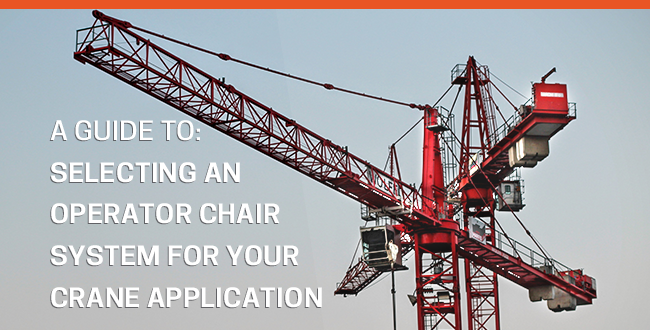
Operator chair systems are critical components that directly impact an operator’s productivity, safety, and comfort. They are instrumental in controlling heavy machinery and navigating through job tasks smoothly. However, there are many available options in the market, and selecting the right chair system can be time-consuming. To ensure you make an informed decision tailored to your specific needs, here are four key elements to consider when choosing an operator chair system, with a focus on J.R. Merritt Controls' products.
Identify Required Control Functionality & Devices
Selecting the appropriate operator chair system for a crane application involves a thorough approach, beginning with identifying the required control functionality and devices. First, assess the specific crane control functions the operator will need to manage directly from their chair system. This could include functions such as crane movement hoisting, lowering, slewing, or emergency controls. Once these functionalities are identified, determine the types and number of controls and devices needed. The number of joysticks, master switches, and pilot devices will directly influence the size and layout of the control console required for the chair system.
For instance, some chair systems have smaller, more compact consoles suitable for basic operations with fewer control elements. Conversely, applications requiring a higher number of controls might necessitate a chair with a larger and deeper console to accommodate multiple joysticks, switches, and displays. It's essential to match the chair's console size and control layout, ensuring that the operator can comfortably and efficiently access all required controls from a seated position. Therefore, a control criteria report is vital for selecting the best chair system setup for optimal performance and operator comfort in crane applications.

Pinpoint Application-Specific Requirements
How will the crane be operated? Under what conditions will operators work? Begin by assessing operational factors such as the duration and frequency of crane use. For high-intensity applications where cranes operate for extended periods each day, think about a chair system with a multitude of adjustments and ergonomic seat options.
Applications, like Ship-to-Shore (STS) or Rubber Tired Gantry (RTG) Cranes, place unique ergonomic demands on operators due to the downward viewing angle. In this scenario, opting for seats with U-cut designs and chair systems with the appropriate adjustments becomes essential. Increased adjustability ensures that operators maintain proper posture and receive adequate support for the neck and back.

In contrast, applications involving stationary pulpits or control rooms, such as those in Waste-to-Energy (WTE) plants, entail long operator shifts. In these types of settings, investing in a chair with a multitude of adjustment capabilities like the Merritt Synergy helps optimize comfort and reduce stressful seating positions for operators of all statures, during extended work hours. Considering the diverse operational characteristics and ergonomic needs of different crane applications enables organizations to select operator chair systems that enhance operator well-being, productivity, and safety.
Review the Installation of Space
Look over the dimensions and layout of the cab, pulpit, or control room to determine the appropriate chair system size and configuration. In environments with limited space, opt for a chair system with slimmer consoles or a small footprint to maximize available space.
For smaller installation spaces, consider chairs with a rotating base feature. This allows the entire chair system to swivel, enabling the operator to effortlessly turn towards the glass or operating area without having to strain or reposition themselves manually. Additionally, explore the option of incorporating floor slides into the chair system setup for stationary installations. This feature facilitates smooth movement of the chair within confined spaces and is particularly beneficial in compact environments where maneuverability is limited but operator mobility is essential.
Survey The Crane & Machine Operator
Surveying crane or machine operators is fundamental in selecting the right operator chair system for your application. Whether buying a new crane or upgrading an existing setup, gathering feedback directly from operators helps identify key features and operational improvements. Discuss essential chair system adjustments and features with operators, including adjustable seat height, lumbar support, and armrest positioning. Secondly, determine if operators find it easy to reach and operate the control devices, and buttons on their console. Explore potential adjustments in console layout or device placement to optimize efficiency and user experience during crane operations. Lastly, inquire about joystick handle styles some operators may prefer specific grip designs (e.g., fighter grip, standard handle, T-handle) based on comfort or ease of use. Understanding these preferences ensures that the selected chair system incorporates joystick handles that align with operator expectations and operational requirements. Actively involving operators in the chair system selection process and considering their feedback on adjustments, device placement, and joystick handle styles, can strengthen operator productivity, and safety within crane operations.
In conclusion, the decision to select the appropriate operator chair system for your crane application influences operator productivity, safety, and comfort. Given the multitude of choices in the market, making a well-informed decision customized to your requirements is crucial. This guide has provided insights into four essential considerations: Identifying Required Control Functionality & Devices, Pinpointing Application-Specific Requirements, Reviewing Installation Space, and Surveying Crane & Machine Operators. These factors, coupled with a focus on J.R. Merritt Controls' products, offer a comprehensive framework for optimizing your chair system selection process.